manual transmission CHEVROLET S10 1996 2.G User Guide
[x] Cancel search | Manufacturer: CHEVROLET, Model Year: 1996, Model line: S10, Model: CHEVROLET S10 1996 2.GPages: 375, PDF Size: 20.73 MB
Page 70 of 375
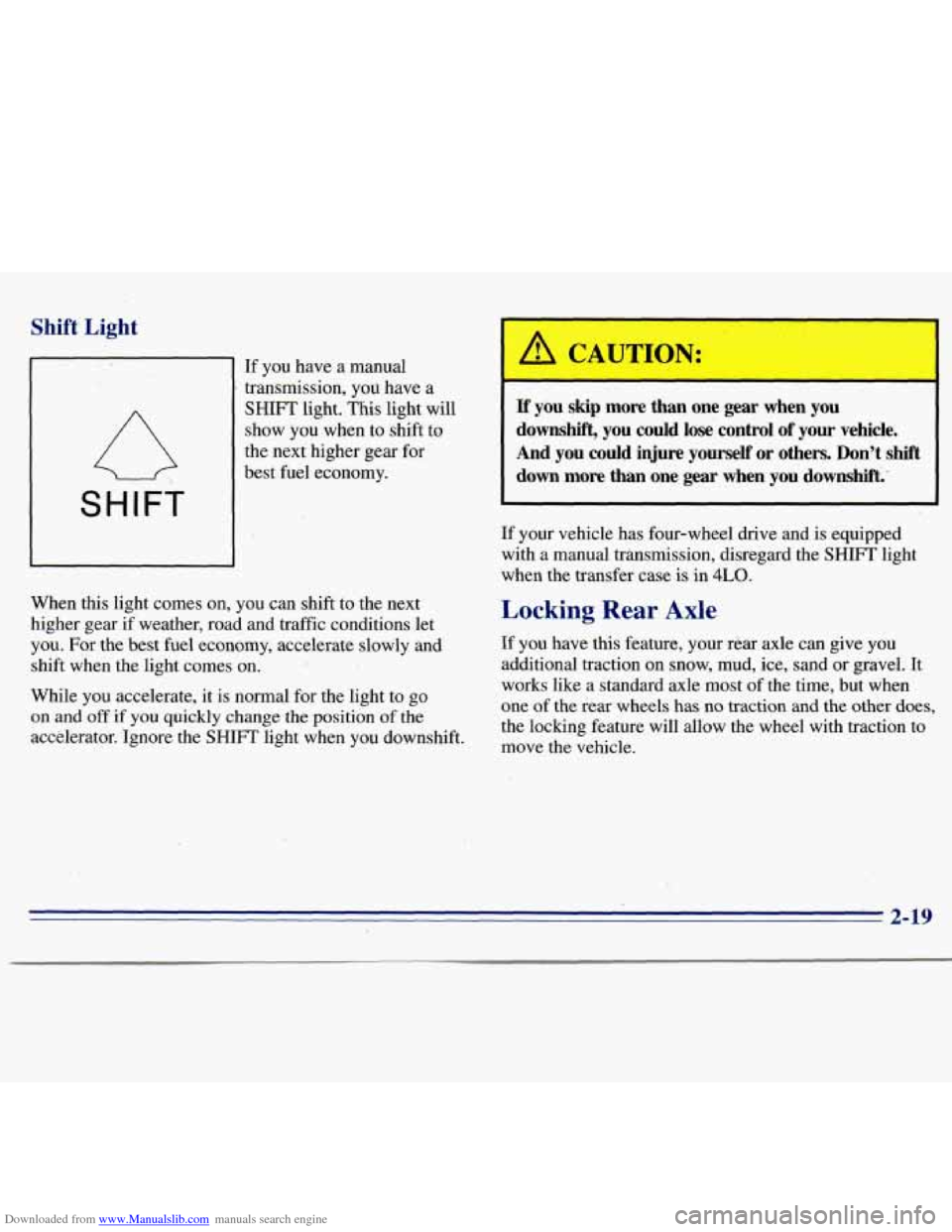
Downloaded from www.Manualslib.com manuals search engine Shift Light
SHIFT
If you have a manual
transmission, you have a
SHIFT light. This light will
show you when to shift
to
the next higher gear for
best fuel economy.
When this light comes on,
you can shift to the next
higher gear
if weather, road and traffic conditions let
you.
For the best fuel economy, accelerate slowly and
shift when
the light comes on.
While you accelerate, it is normal for the light to go
on
and off if you quickly change the position of the
accelerator. 'Ignore the SHIFT light when you downshift.
a CAUTION:
If you skip more than one gear when you
downshift, you could lose' control of your vehicle.
And
you could injure yourself' or others. Don't shift
down more than one gear when you downshift.'
If your vehicle has four-wheel drive and is equipped
with a manual transmission, disregard the
SHIFT light
when the transfer case
is in 4LO.
Locking Rear Axle
If you have this feature, your rear axle can give you
additional traction on snow, mud, ice, sad or gravel. It
works like a standard axle most of the time, but when
one
of the rear wheels has no traction and the other does,
the locking feature will allow the wheel with traction to
move the vehicle.
Page 73 of 375
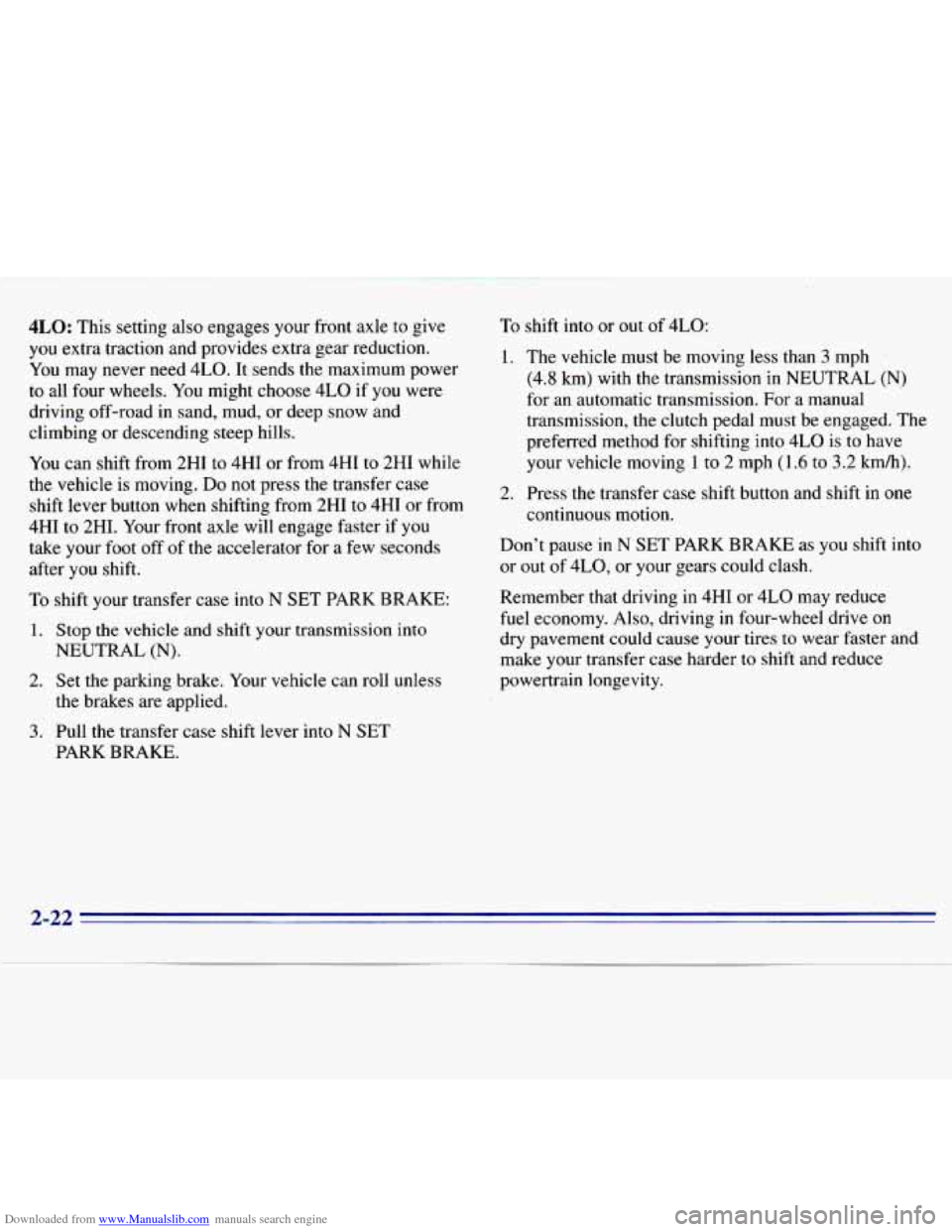
Downloaded from www.Manualslib.com manuals search engine 4LO: This setting also engages your front axle to give
you extra traction and provides extra gear reduction.
You may never need 4LO. It sends the maximum power
to all four wheels. You might choose 4LO
if you were
driving off-road in sand, mud, or deep snow and
climbing or descending steep hills.
You can shift from 2HI to 4HI or from 4HI to 2HI while
the vehicle is moving.
Do not press the transfer case
shift lever button when shifting from 2HI to 4HI
or from
4HI to 2HI. Your front axle will engage faster
if you
take your foot
off of the accelerator for a few seconds
after you shift.
To shift your transfer case into
N SET PARK BRAKE:
1. Stop the vehicle and shift your transmission into
2. Set the parking brake. Your vehicle can roll unless
NEUTRAL
(N).
the brakes
are applied.
3. Pull the transfer case shift lever into N SET
PARK BRAKE.
To shift into or out of 4LO:
1. The vehicle must be moving less than 3 mph
(4.8
km) with the transmission in NEUTRAL (N)
for an automatic transmission. For a ,manual
transmission, the clutch pedal must be engaged. The
preferred method for shifting into 4LO is to have
your vehicle moving 1 to 2 mph (1.6 to 3.2 km/h).
2. Press the transfer case shift button and shift in one
continuous motion.
Don’t pause in
N SET PARK BRAKE as you shift into
or out
of 4L0, or your gears could clash.
Remember that driving in 4HI or
4LO may reduce
fuel economy. Also, driving in four-wheel drive
on
dry pavement could cause your tires to wear faster and
make your transfer case harder to shift and reduce
powertrain longevity.
2-22
Page 74 of 375
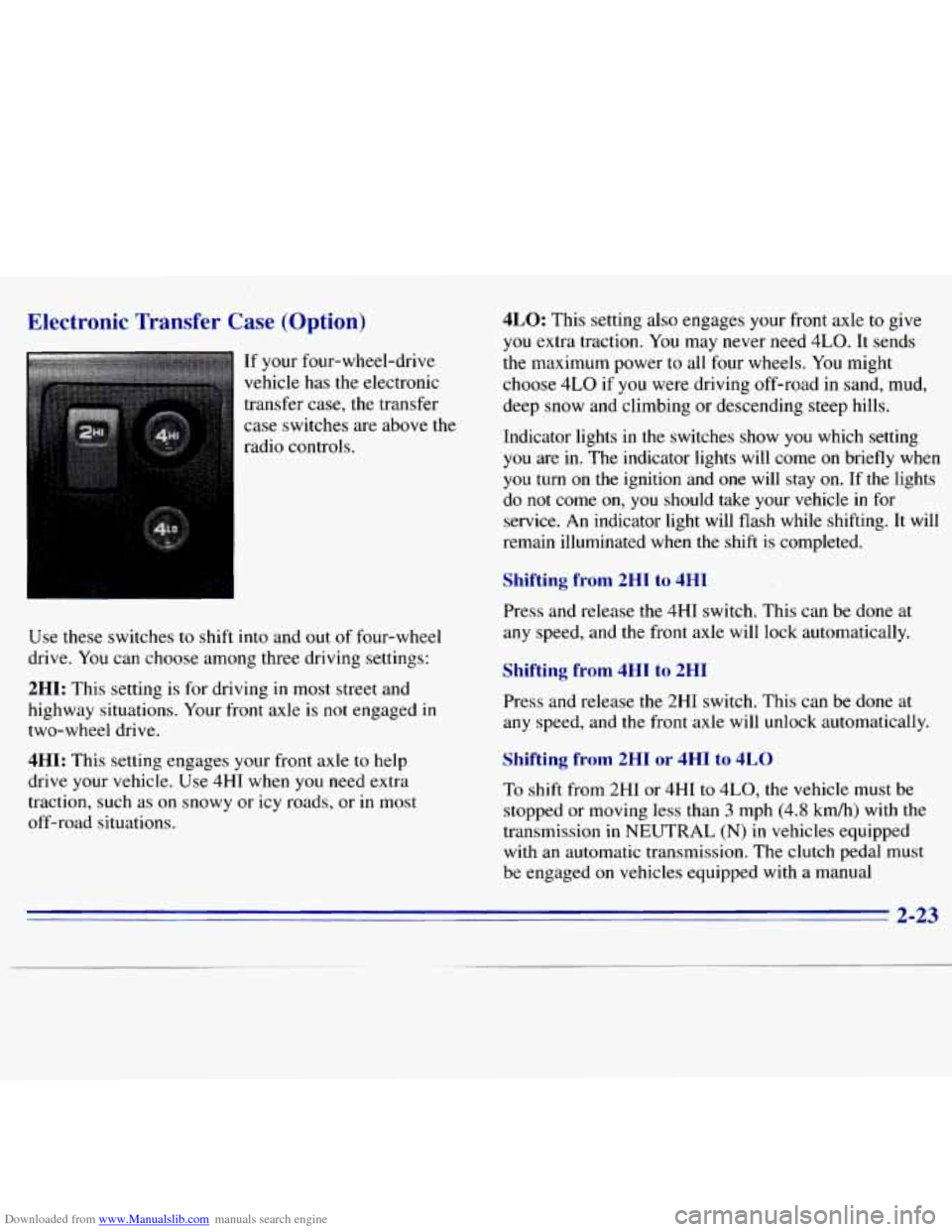
Downloaded from www.Manualslib.com manuals search engine Electronic Transfer Case (Option)
If your four-wheel-drive
vehicle has the electronic
transfer case, the transfer case switches are above the
radio controls.
Use these switches
to shift into and out of four-wheel
drive. You can choose among three driving settings:
2HI: This setting is for driving in most street and
highway situations. Your front axle is not engaged in
two-wheel drive.
4HI: This setting engages your front axle to help
drive your vehicle.
.Use 4HI when you need extra
traction, such as on snowy or icy roads, or
in most
off-road situations.
4LO: This setting also engages your front axle to give
you extra traction. You may never need
4LO. It sends
the maximum power to all four wheels.
You might
choose
4LO if you were driving off-road in sand, mud,
deep snow and climbing or descending steep hills.
Indicator lights in the switches show
you which setting
you are in. The indicator lights will come on briefly when
you turn on the ignition and one will stay on. If the lights
do
not come on, you should take your vehicle in for
service.
An indicator light will flash while shifting. It will
remain illuminated when
the shift is completed.
Shifting from 2HI to 4HI
Press and release the 4HI switch. This can be done at
any speed, and the front axle will lock automatically.
Shifting from 4HI to 2HI
Press and release the 2HI switch. This can be done at
any speed, and the front axle will unlock automatically.
Shifting from 2HI or 4HI to 4LO
To shift from 2HI or 4HI to 4L0, the vehicle must be
stopped or moving less than
3 mph (4.8 kmh) with the
transmission
in NEUTRAL (N) in vehicles equipped
with an automatic transmission. The clutch pedal
must
be engaged on vehicles equipped with a manual
2-23
Page 75 of 375
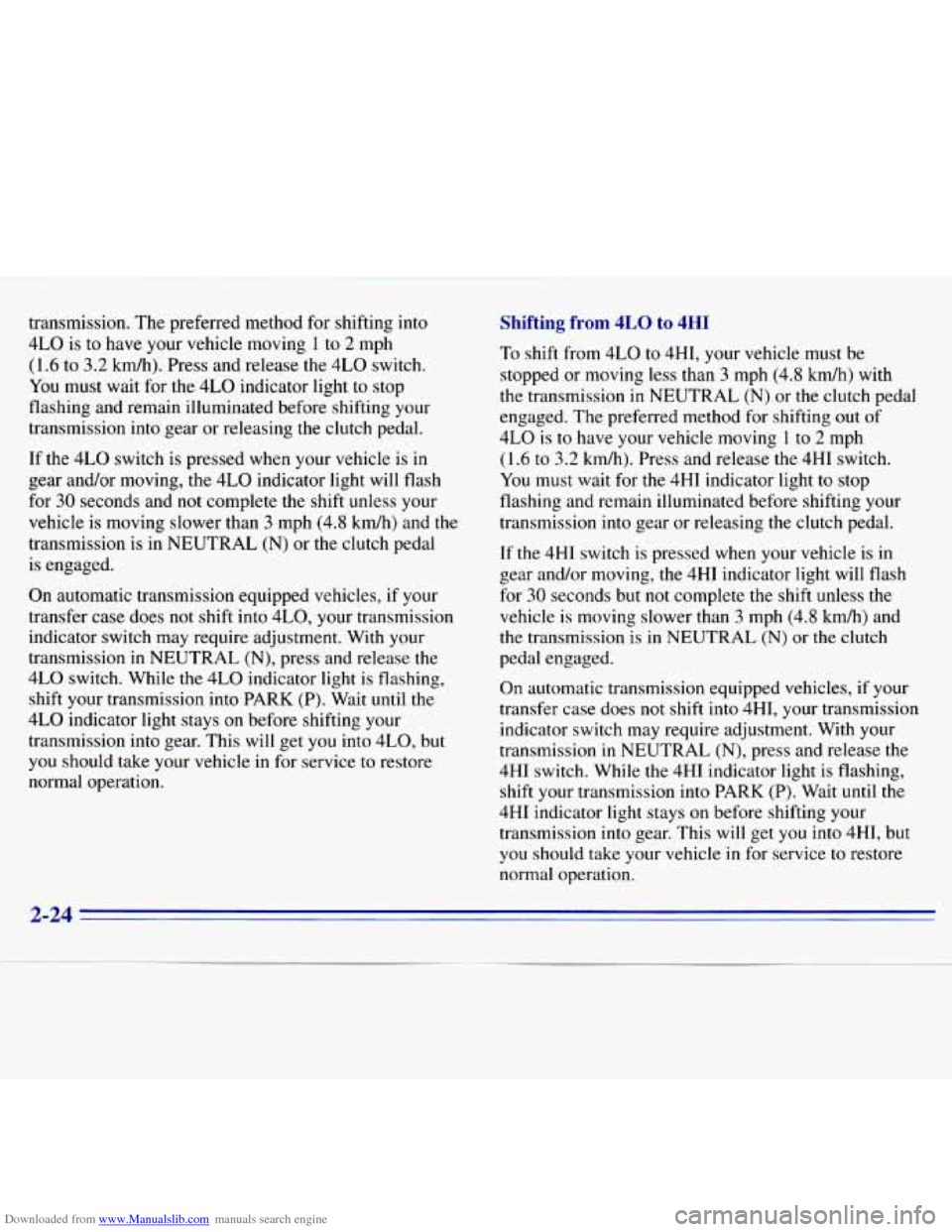
Downloaded from www.Manualslib.com manuals search engine transmission. The preferred method for shifting into
4LO is to have your vehicle moving 1 to 2 mph
(1.6 to 3.2
kmh). Press and release the 4LO switch.
You must wait for the 4LO indicator light
to stop
flashing and remain illuminated before shifting your
transmission into gear or releasing the clutch pedal.
If the 4LO switch is pressed when your vehicle is in
gear and/or moving, the 4LO indicator light will flash
for
30 seconds and not complete the shift unless your
vehicle is moving slower than
3 mph (4.8 km/h) and the
transmission is in NEUTRAL (N) or the clutch pedal
is engaged.
On automatic transmission equipped vehicles, if your
transfer
case does not shift into 4L0, your transmission
indicator switch may require adjustment. With your
transmission
in NEUTRAL (N), press and release the
4LO switch. While the 4LO indicator light is flashing,
shift your transmission into
PARK (P). Wait until the
4LO indicator light stays
on before shifting your
transmission into gear. This will get
you into 4L0, but
you should take your vehicle in for service
to restore
normal operation.
Shifting from 4LO to 4HI
To shift from 4LO to 4H1, yo Iur vehicle must be
stopped
or moving less than 3 mph (4.8 kmh) with
the transmission in NEUTRAL
(N).or the clutch pedal
engaged. The preferred method for shifting out
of
4LO is to have your vehicle moving 1 to 2 mph
(1.6 to 3.2 km/h). Press and release the 4HI switch.
You must wait for the 4HI indicator light to stop
flashing and remain illuminated before shifting your
transmission into gear or releasing the clutch pedal.
If the 4HI switch is pressed when your vehicle is in
gear and/or moving, the 4HI indicator light will flash
for 30 seconds but not complete the shift unless the
vehicle
is moving slower than 3 mph (4.8 kmh) and
the transmission is in
NEUTRAL (N) or the clutch
pedal engaged.
On automatic transmission equipped vehicles, if your
transfer case does
not shift into 4H1, your transmission
indicator switch may require adjustment. With your
transmission in NEUTRAL
(N), press and release the
4HI switch. While the 4HI indicator light is flashing,
shift your transmission into PARK
(P). Wait until the
4HI indicator light stays on before shifting your
transmission into gear. This will get
you into 4H1, but
you should take your vehicle
in for service to restore
normal operation.
2-24
Page 78 of 375
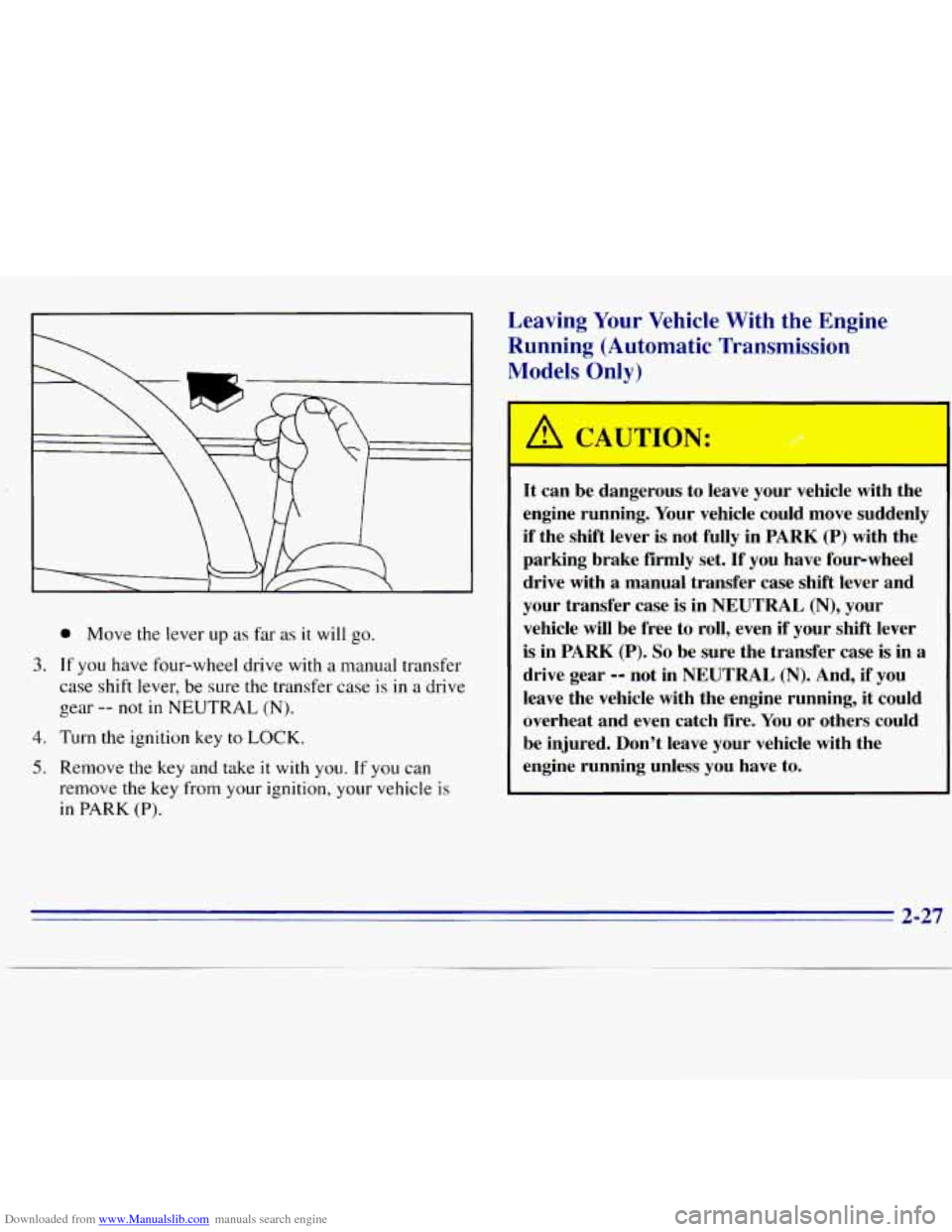
Downloaded from www.Manualslib.com manuals search engine Leaving Your Vehicle With the Engine
Running (Automatic Transmission
Models
0 lv)
@ Move the lever up as far as it will go.
3. If you have four-wheel drive with a manual transfer
case shift lever, be sure the transfer case is in
a drive
gear
-- not in NEUTRAL (N).
4. Turn the ignition key to LOCK.
5. Remove the key and take it with you. If you can
remove the key from
your ignition, your vehicle is
in PARK (P).
A CAUTION:
It can be dangerous to leave your vehicle with the
engine running. Your vehicle could move suddenly
if the shift lever is not fully in PARK
(P) with the
parking brake firmly set. If you have four-wheel
drive with
a manual transfer case shift lever and
your transfer case is in NEUTRAL
(N), your
vehicle will be free to roll, even
if your shift lever,
is in PARK (P).
So be sure the transfer case is in a
drive gear -9 not in NEUTRAL (N). And, if you
leave the vehicle with the engine running, it could
overheat and even catch fire. You or others could
be injured. Don’t leave your vehicle with the
engine running unless you have to.
2-27
Page 79 of 375
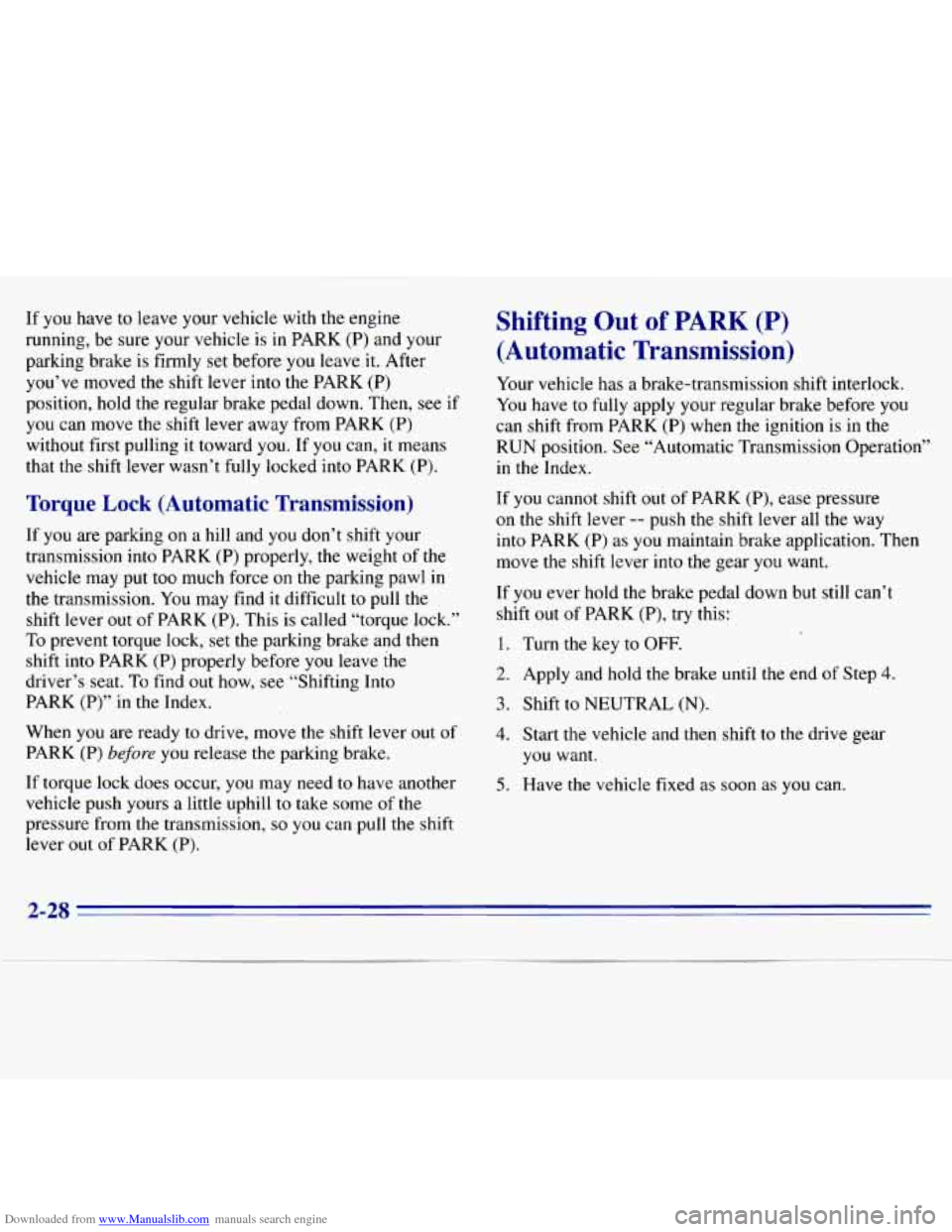
Downloaded from www.Manualslib.com manuals search engine If you have to leave your vehicle with the engine
running, be sure your vehicle
is in PARK (P) and your
parking brake is firmly set before you leave
it. After
you’ve moved the shift lever into the PARK (P)
position, hold the regular brake pedal down. Then, see if
you can move the shift lever away from PARK (P)
without first pulling it toward you. If
you can, it means
that the shift lever wasn’t fully locked into PARK (P).
Torque Lock (Automatic Transmission)
If you are parking on a hill and you don’t shift your
transmission into PARK (P) properly, the weight of the
vehicle may put too much force
on the parking pawl in
the transmission. You may find it difficult to pull the
shift lever out
of PARK (P). This is called “torque lock.”
To prevent torque lock, set the parking brake and then
shift into PARK (P) properly before you leave the
driver’s seat.
To find out how, see “Shifting Into
PARK (P)” in the Index.
When you are ready to drive, move the shift lever
out of
PARK (P)
before you release the parking brake.
If torque lock does occur, you may need to have another
vehicle push yours a little uphill
to take some of the
pressure from the transmission,
so you can pull the shift
lever
out of PARK (P).
Shifting Out of PARK (P)
(Automatic Transmission)
Your vehicle has a brake-transmission shift interlock.
You have to fully apply your regular brake before you
can shift from
PARK (P) when the ignition is in the
RUN position. See “Automatic Transmission Operation”
in the Index.
If
you cannot shift out of PARK (P), ease pressure
on the shift lever -- push the shift lever all the way
into PARK (P) as you maintain brake application. Then
move the shift lever into the gear you want.
If you ever hold the brake pedal down but still can’t
shift out
of PARK (P), try this:
1. Turn the key to OFF.
2. Apply and hold the brake until the end of Step 4.
3. Shift to NEUTRAL (N).
4. Start the vehicle and then shift to the drive gear
you want.
5. Have the vehicle fixed as soon as you can.
2-28
Page 80 of 375
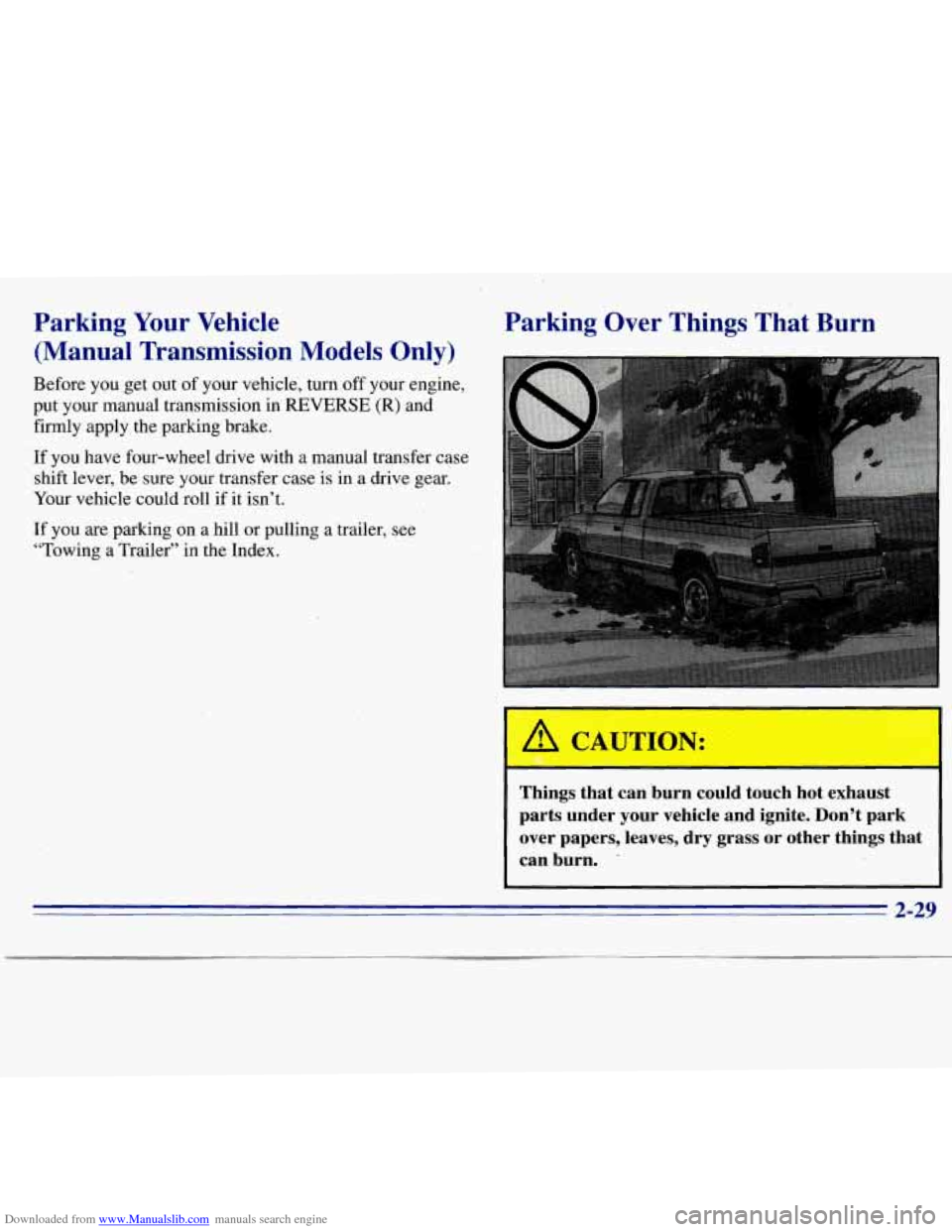
Downloaded from www.Manualslib.com manuals search engine Parking Your Vehicle
(Manual Transmission Models
Only)
If you have four-wheel drive with a manual transfer case
shift lever, be sure your transfer case is in a drive gear.
Your vehicle could roll if it isn’t.
If you are parking
on a hill or pulling a trailer, see
“Towing a Trailer” in the Index.
Parking Over Things That Burn
Before you get out of your vehicle’, turn off your engine,
put your manual transmission in
REVERSE (R) and
firmly apply the parking brake.
Things that can burn could touch hot exhaust
parts under your vehicle and ignite. Don’t park
over papers, leaves, dry grass or other things that
can burn.
-
2-29
Page 81 of 375
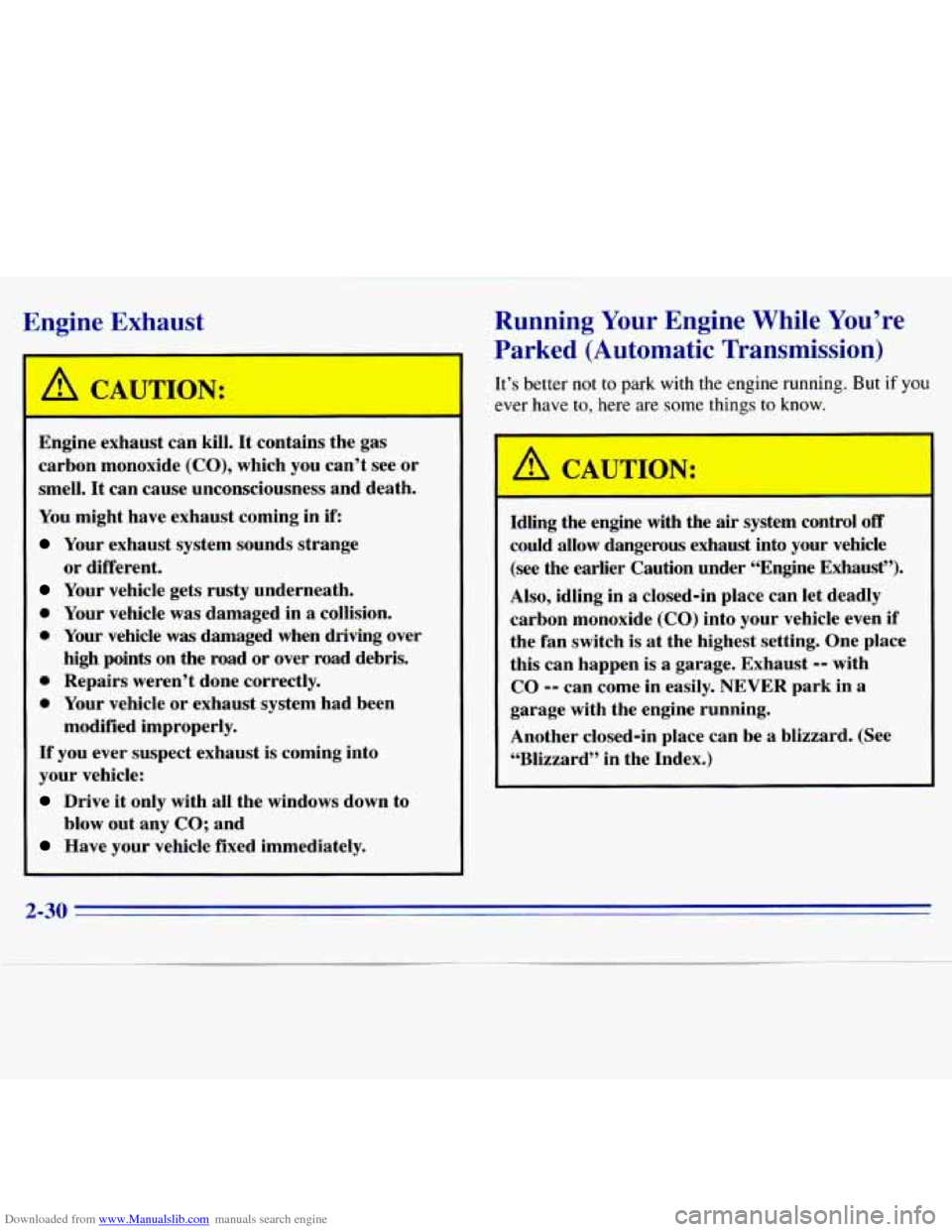
Downloaded from www.Manualslib.com manuals search engine Engine Exhaust
Engine exhaust can kill. It contains the gas
carbon monoxide
(CO), which you can’t see or
smell. It can cause unconsciousness and death.
You might have exhaust coming in if:
Your exhaust system sounds strange
Your vehicle gets rusty underneath.
0 Your vehicle was damaged in a collision.
0 Your vehicle was damaged when driving over
high points on the road or over road debris.
0 Repairs weren’t done correctly.
0 Your vehicle or exhaust system had been
If you ever suspect exhaust is coming into
your vehicle:
Drive it only with all the windows down to
Have your vehicle fixed immediately.
or
different.
modified improperly.
blow out any
CO; and
Running Your Engine While You’re
Parked (Automatic Transmission)
It’s better not to park with the engine running. But if you
ever have to, here
are some things to know.
--
A CAUTION:
Idling the engine with the air system control off
could allow dangerous exhaust into your vehicle
(see the earlier Caution under “Engine Exhaust”).
Also, idling in a closed-in place can let deadly
carbon monoxide
(CO) into your vehicle even if
the fan switch is at the highest setting. One place
this can happen is a garage. Exhaust
-- with
CO -- can come in easily. NEVER park in a
garage with the engine running.
Another closed-in place can be a blizzard. (See
“Blizzard”
in the Index.)
2-30
Page 87 of 375
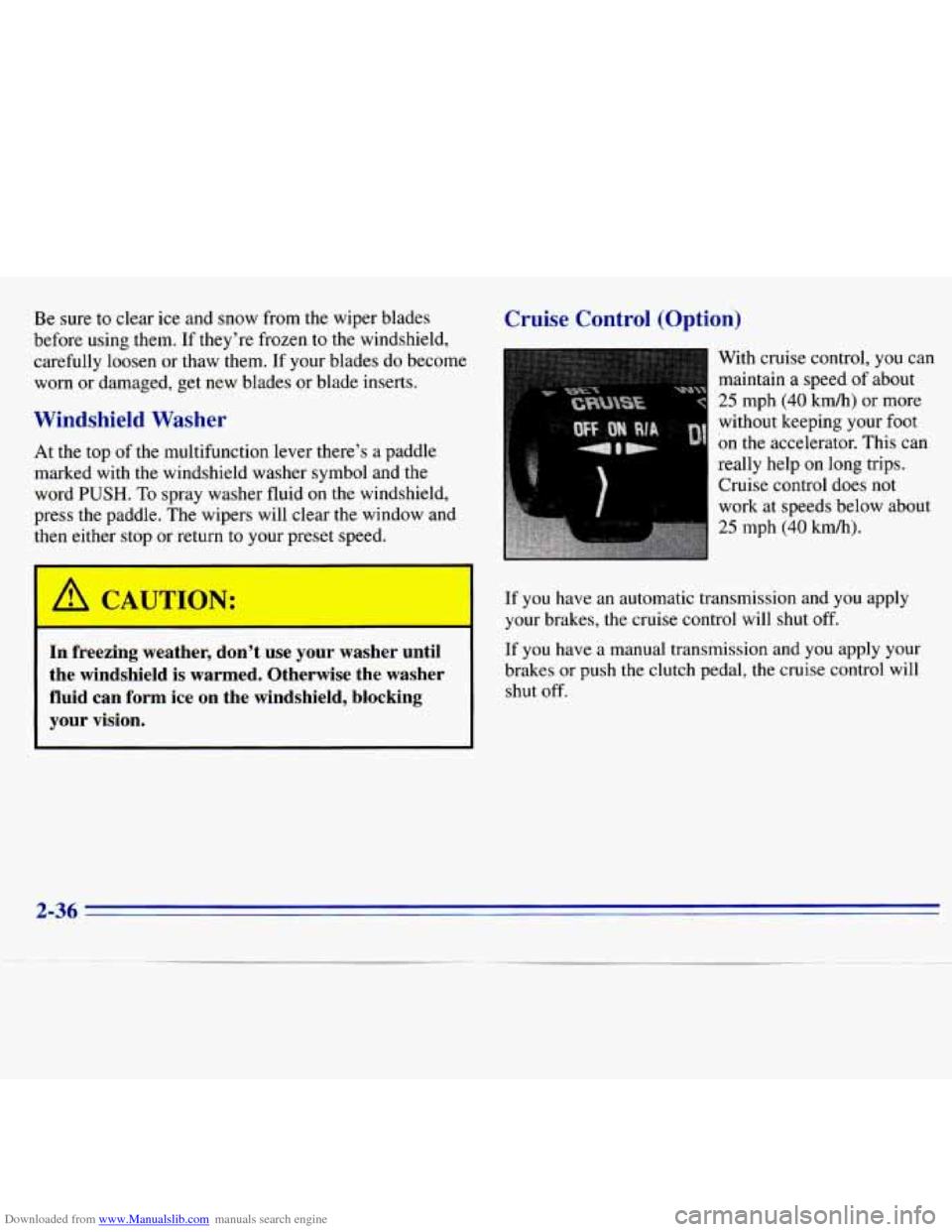
Downloaded from www.Manualslib.com manuals search engine Be sure to clear ice and snow from the wiper blades
before
using them. If they’re frozen to the windshield,
carefully loosen or thaw them.
If your blades do become
worn or damaged, get new blades or blade inserts.
Windshield Washer
At the top of the multifunction lever there’s a paddle
marked with the windshield washer symbol and the
word
PUSH. To spray washer fluid on the windshield,
press the paddle. The wipers will clear the window and
then either stop or return to your preset speed.
Cruise Control (Option)
With cruise control, you can
maintain a speed
of about
25 mph (40 km/h) or more
without keeping your
foot
on the accelerator. This can
really help on long trips.
Cruise control does not
work at speeds below about
25 mph (40 km/h).
-’ C SJTIC -J: If you have an automatic transmission and you apply
-- your brakes, the cruise control will shut off.
In freezing weather, don’t use your washer until If you have a manual transmission and you apply your
the windshield is warmed. Otherwise the washer brakes or push the clutch pedal, the cruise control will
fluid can form ice on the windshield, blocking shut off.
your vision.
2-36
Page 90 of 375
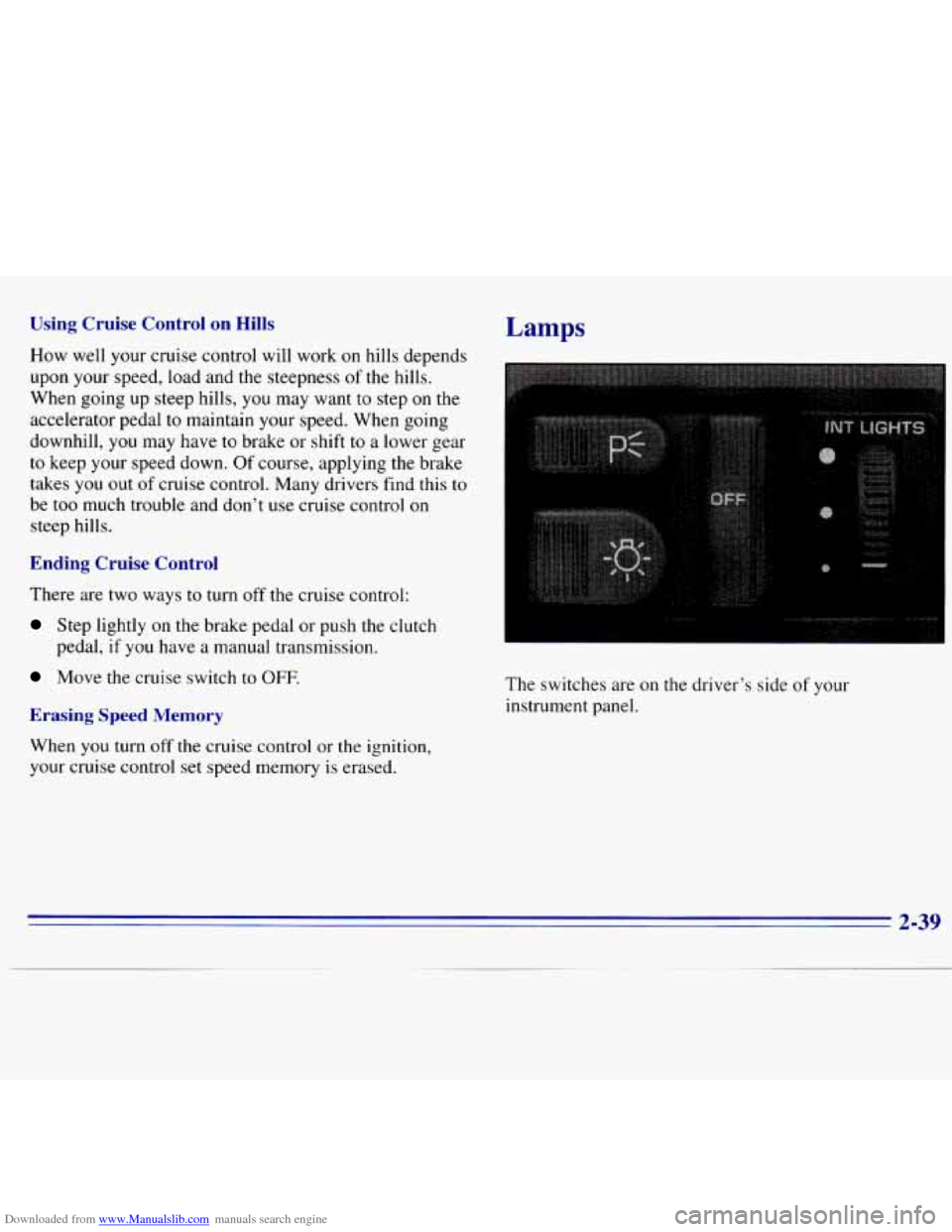
Downloaded from www.Manualslib.com manuals search engine Using Cruise Control on Hills
How well your cruise control will work on hills depends
upon your speed, load and the steepness
of the hills.
When going up steep hills,
you may want to step on the
accelerator pedal to maintain your speed. When going
downhill,
you may have to brake or shift to a lower gear
to keep your speed down. Of course, applying the brake
takes you out of cruise control. Many drivers find
this to
be too much trouble and don’t use cruise control on
steep hills.
Ending Cruise Control
There are two ways to turn off the cruise control:
Step lightly on the brake pedal or push the clutch
pedal, if
you have a manual transmission.
Move the cruise switch to OFF.
Erasing Speed Memory
When you turn off the cruise control or the ignition,
your cruise control set speed memory is erased.
Lamps
The switches are on the driver’s side of your
instrument panel.
2-39